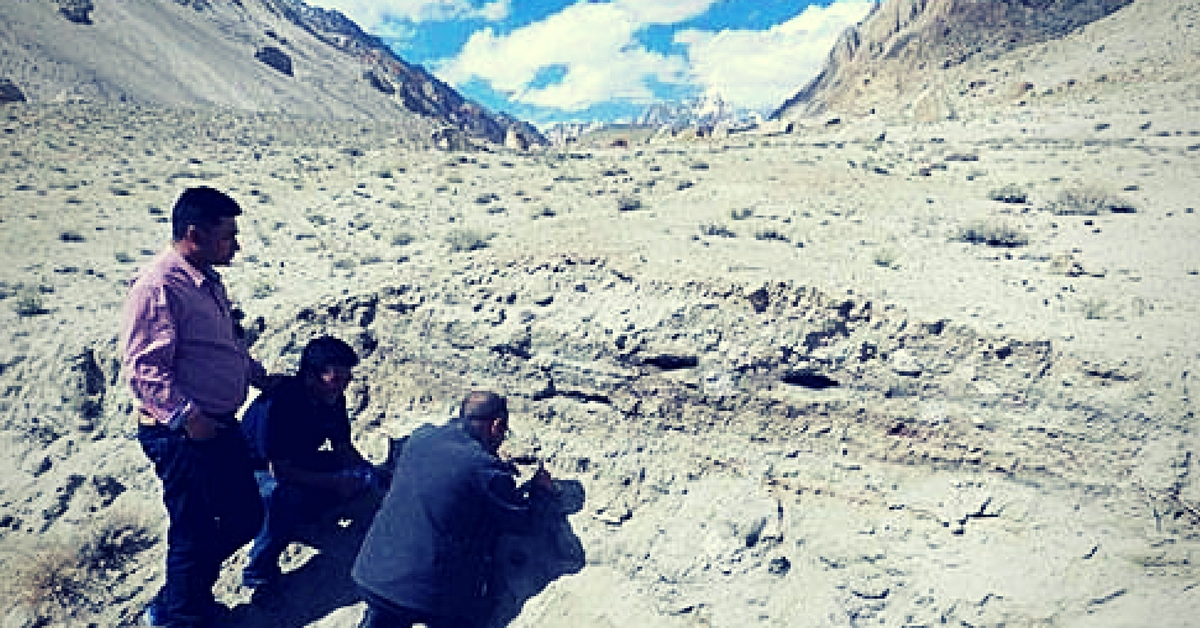Why a Recently Unearthed 10,500-Year-Old Camping Site in Ladakh Just Made History
The Archaeological Survey of India has unearthed a 10,500-year-old camping site in Ladakh. A release issued by the Ministry of Culture states that the site is located on the way to Saser La near the Karakoram Pass.

The Archaeological Survey of India has unearthed a 10,500-year-old camping site in Ladakh. A release issued by the Ministry of Culture states that the site is located on the way to Saser La near the Karakoram Pass in Ladakh. A team headed by Dr. S.B. Ota, the Joint Director General of ASI, stumbled upon the site while exploring the Nubra Valley in 2015-16.
It is located 14,000 feet above sea level. The ASI team found that a section of the road leading to the Saser stream was exposed due to road construction and was showing successive layers of burnt residue.

Image Source: pib.nic.in
The press release describes the site as “a small flat area with snow-covered peaks on one extreme, dry barren land with loose rocks all around and gushing stream within the deep western gorges, an ideal place for camping in a picturesque setting.”
ASI sent the charcoal samples from the site to BETA lab in Florida, USA, for radiocarbon determination. The archaeologists were shocked when the results came because it was revealed that the samples were from 8,500 BC. This is the first time that ASI has unearthed such an ancient campsite from that region.
A team of officials from ASI inspected the site again in the month of July. New samples of charcoal and bones were sent for inspection to confirm the accuracy of the carbon dating done earlier, and it was established that humans once occupied the camping site. The new study also suggests repeated human activity in this area for about 800 years. Proper archaeological excavations are being planned by ASI to determine the nature of pre-historic camping patterns, the extent of camping and other cultural aspects of the people who lived here.
“There seems to be, at the outset, no proof of organised housing. This could mean that the people belonged to the Neolithic Age – a transitory phase from hunting-gathering to basic farming,” Anindya Sarkar, head of the department of geology and geophysics at IIT Kharagpur, told DNA.
Like this story? Or have something to share? Write to us: [email protected], or connect with us on Facebook and Twitter (@thebetterindia).

Similar Story

Want to Play a Role in Shaping India’s Climate Laws & Policies? Here’s a One-Stop Guide
Civis, a platform that enables citizens to participate in public consultations in the domain of environment and policy has released Climate Voices. This is a handbook and guide for Indians to participate in environmental law-making and play an active role in shaping our climate policies.
Read more >
If you found our stories insightful, informative, or even just enjoyable, we invite you to consider making a voluntary payment to support the work we do at The Better India. Your contribution helps us continue producing quality content that educates, inspires, and drives positive change.
Choose one of the payment options below for your contribution-
By paying for the stories you value, you directly contribute to sustaining our efforts focused on making a difference in the world. Together, let's ensure that impactful stories continue to be told and shared, enriching lives and communities alike.
Thank you for your support. Here are some frequently asked questions you might find helpful to know why you are contributing?


This story made me
-
97
-
121
-
89
-
167












